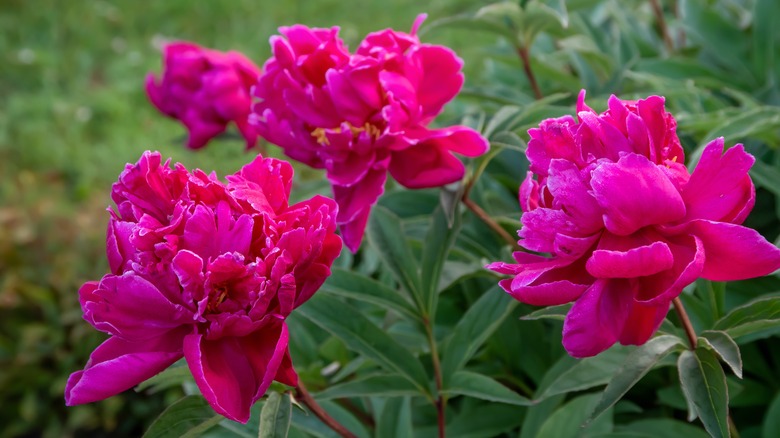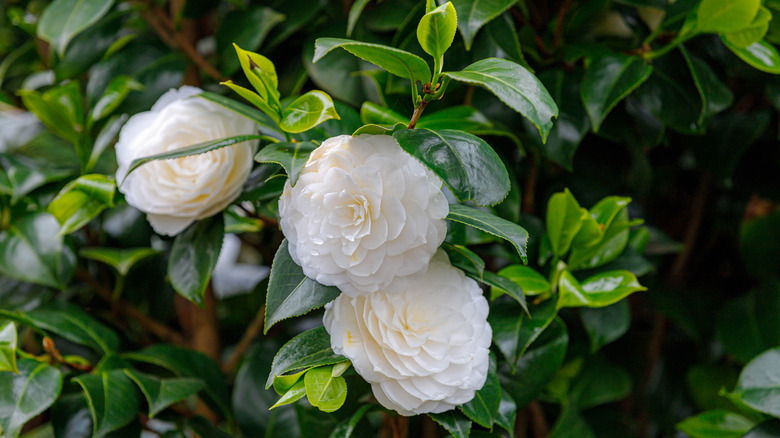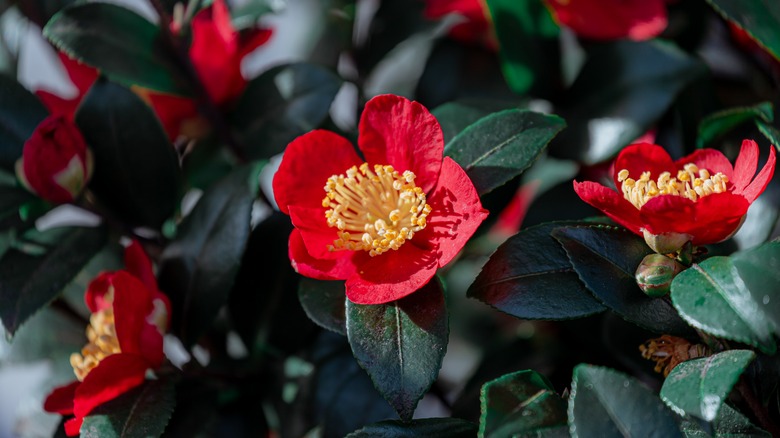Love Peonies But Live Out Of Their Growing Zone? Try Planting This Colorful Flower
Peonies are a very popular spring-blooming perennial, loved for their floriferous, colorful blooms that light up the late spring garden. Peonies need cold winter temperatures to benefit their growth cycle, so growing peonies in warmer growing zones can be very tricky. But there is a warm-weather perennial with similar-looking flowers that is perfect for warmer garden zones. The fluffy petals of the camellia, in shades of pink and white, make it a notable peony lookalike, and it thrives in USDA Zones 7-9.
Growing camellias in the garden is fairly easy, and they tend to be very long-lived (like peonies). The full, many-petalled flowers can bloom from November through April in optimal conditions. Being a tropical plant, camellias thrive in warm, humid weather. They don't do well with salty air, so they don't make a suitable coastal plant.
Given their tendency to bloom through the winter months, camellia shrubs are also evergreen, with waxy, dark green leaves that stay attractive year-round. They come in a range of sizes, from small and compact to large and sprawling, and the variety of colors is breathtaking. Have a look at the options that are available in local nurseries, or via mail order, to choose the best size, shape, and color that's suitable for your garden.
Choosing the best camellia for your garden
Camellias come in a number of beautiful cultivars for home gardeners. The shrubs grow in a wide, rounded shape, and their mature heights range in size from 4 to 16 feet tall, with most varieties somewhere between 6 to 10 feet tall. The flower petals may be in a single layer, with pretty gold-yellow stamens, or they may be doubles with fluffy layers of petals. The colors of camellia flowers range from snow white to cream, light pink, rose pink, bright pink, lavender, and red, mostly solid colors but some with variegated petals.
Some of the most popular varieties are Bonnie Marie (fluffy rose pink double flowers), Fragrant Pink (deliciously scented, small lavender-pink double flowers), Black Magic (dark coral red double), Debutante (light pink flowers that resemble roses), and Margaret Davis (white with dark red edges). There are also several slightly more cold-tolerant hybrid camellias, hardy to Zone 6, including April Blush (pale apricot-pink singles), Snow Flurry (bright white double flowers that resemble peonies), and Winter's Star (delicate pink single blooms).
Different camellia cultivars have different light needs. Like other warm zone evergreen shrubs, they prefer a spot with dappled shade, or with morning sun and afternoon shade. Too much sun on a warm day can cause the flowers of Camellia japonica cultivars to droop or dry out, so a location with more than four hours of direct sun, or late afternoon sun, is not suitable for them.
Planting and caring for camellias
When planting camellia shrubs, be sure to choose a site with well-drained soil. They also like slightly acidic soil, so planting them with some amendments (such as peat moss or used coffee grounds) to improve soil acidity is also a good idea. Regular watering is crucial to keep camellias healthy and blooming. Watering thoroughly twice per week during the blooming season is recommended. Water the shrub at the roots for optimum distribution of moisture to all parts of the plant. A light layer of natural mulch (such as pine bark mulch) will also help your camellia to retain moisture.
You can fertilize your camellia if desired, using a basic slow-release NPK fertilizer. Be careful not to overfertilize, as too much nitrogen can damage the leaves. Fertilize in spring or summer, but no later than August, to avoid encouraging too much late-season growth close to winter. There are also special fertilizers designed specifically for camellias.
As far as pruning is concerned, your camellia shrubs will benefit from as little pruning as possible, to help preserve their naturally rounded shape. You can trim any broken, dead, or diseased branches, but otherwise prune your camellia very sparingly. The best time to prune them is after the blooms in spring have started to fade, to prepare them for forming new growth. Once established, your camellias will give you many years of beautiful blooms with very little maintenance required, other than regular watering.


